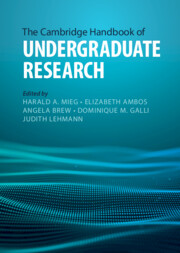Book contents
- The Cambridge Handbook of Undergraduate Research
- The Cambridge Handbook of Undergraduate Research
- Copyright page
- Contents
- Figures
- Tables
- Contributors
- Foreword
- Foreword
- 1 Introduction
- Part I Theory and Research on Undergraduate Research
- Part II Implementation, Approaches, Methods
- Part III Disciplines
- Part IV International Perspective
- 47 Introduction
- Part IV.1 Americas
- Part IV.2 Africa & Middle East
- Part IV.3 Asia & Oceania
- Part IV.4 Europe
- Part V Avenues for Developing Undergraduate Research
- Index
- References
Part IV.3 - Asia & Oceania
from Part IV - International Perspective
Published online by Cambridge University Press: 11 August 2022
- The Cambridge Handbook of Undergraduate Research
- The Cambridge Handbook of Undergraduate Research
- Copyright page
- Contents
- Figures
- Tables
- Contributors
- Foreword
- Foreword
- 1 Introduction
- Part I Theory and Research on Undergraduate Research
- Part II Implementation, Approaches, Methods
- Part III Disciplines
- Part IV International Perspective
- 47 Introduction
- Part IV.1 Americas
- Part IV.2 Africa & Middle East
- Part IV.3 Asia & Oceania
- Part IV.4 Europe
- Part V Avenues for Developing Undergraduate Research
- Index
- References
Summary

- Type
- Chapter
- Information
- The Cambridge Handbook of Undergraduate Research , pp. 533 - 580Publisher: Cambridge University PressPrint publication year: 2022

